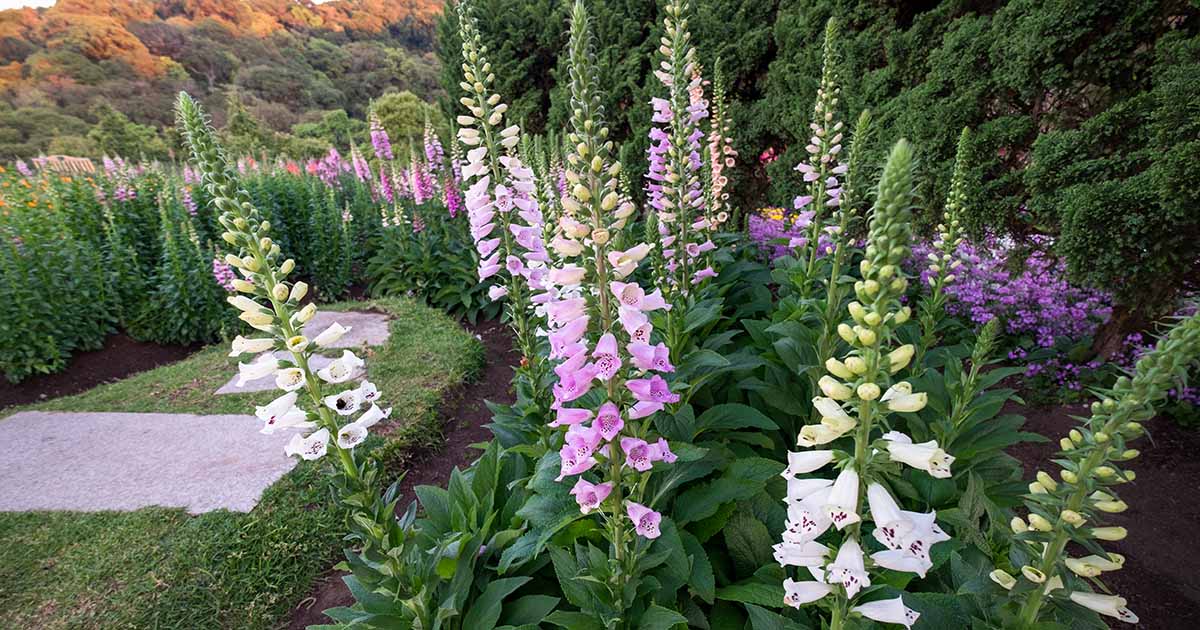Foxgloves plants, known for their striking spires of tubular flowers, have long been a favourite among gardeners. These plants, belonging to the genus Digitalis, are celebrated not only for their aesthetic appeal but also for their numerous benefits in garden settings. Whether you are an experienced gardener or a beginner looking to enhance your outdoor space, incorporating foxgloves into your garden can bring about significant advantages. In this article, we’ll explore ten incredible benefits of adding foxgloves plants to your garden, from their visual appeal to their ecological contributions.
Foxgloves Plants: A Stunning Visual Impact
One of the primary reasons gardeners choose foxglove plants is their stunning visual impact. With their tall spikes adorned with bell-shaped flowers, foxgloves create a dramatic focal point in any garden. They come in a range of colours, including pink, purple, white, and yellow, making them versatile for various garden themes. The unique structure of foxglove plants adds vertical interest, breaking up the monotony of flat garden beds and drawing the eye upward.
Foxgloves Plants: Attract Pollinators to Your Garden
Foxgloves plants are excellent for attracting pollinators such as bees, butterflies, and hummingbirds. The tubular flowers of foxgloves provide an accessible source of nectar for these beneficial creatures. By planting foxgloves, you create a welcoming environment for pollinators, which is crucial for the health and productivity of your garden. Increased pollination can lead to better fruit and vegetable yields, enhancing the overall success of your garden.
Foxgloves Plants: Enhance Garden Biodiversity
Incorporating foxgloves plants into your garden helps enhance biodiversity. These plants provide habitat and food for various wildlife species, including insects and birds. By supporting a diverse range of organisms, you contribute to a balanced and resilient garden ecosystem. Biodiversity is key to maintaining soil health, pest control, and overall garden vitality.
Foxgloves Plants: Low Maintenance and Hardy
Foxgloves plants are known for their hardiness and low maintenance requirements. Once established, they can thrive in a variety of soil types and conditions, including partial shade and well-drained soil. Foxgloves are also resistant to many common garden pests and diseases, making them an ideal choice for gardeners seeking a reliable and low-maintenance plant.
Perfect Solutions for Shaded Areas
If you have areas in your garden that receive limited sunlight, this plant is a perfect solution. Many varieties thrive in partial shade, making them ideal for those tricky spots where other plants might struggle. Their ability to bring vibrant colour and structure to shaded areas ensures that your garden remains lively and attractive even in low-light conditions.
Ideal Features for Cottage Gardens
This plant is a quintessential feature of cottage gardens, adding a touch of charm and whimsy to the landscape. Their tall, elegant spikes and diverse colour palette blend seamlessly with the informal and lush style typical of cottage gardens. Incorporating them can enhance the classic, romantic appeal of your garden, creating a picturesque and inviting atmosphere.
Enjoy Long-Lasting Blooms
One of the key benefits of this plant is its long-lasting blooms, which can extend the flowering season in your garden. Depending on the variety, they can flower from late spring to early summer, providing a continuous display of colour and interest. This extended blooming period helps keep your garden vibrant and engaging throughout the growing season.
Versatility in Heights and Sizes
The versatility in heights and sizes offered by these plants is remarkable. From dwarf varieties suited for the front of the border to tall, statuesque types that make a dramatic statement, there is a variety to fit any garden space. This flexibility allows you to use them in various garden designs, from container gardening to expansive landscape beds.
Natural Pest Repellent Qualities
Certain compounds found in these plants have natural pest-repellent properties. While not a substitute for comprehensive pest management, their presence can help deter some common garden pests. This natural repellent quality can reduce the need for chemical treatments, contributing to a healthier and more eco-friendly garden environment.
Edible and Medicinal Uses
Beyond their ornamental value, some species of this plant have historical medicinal uses. The leaves contain compounds that have been utilised in traditional medicine and modern pharmaceuticals. While these compounds need to be handled with caution due to their toxicity in large quantities, they have played a role in treatments for various health conditions.
Conclusion
Foxgloves plants offer a multitude of benefits that make them a valuable addition to any garden. From their stunning visual impact and ability to attract pollinators to their low maintenance requirements and suitability for shaded areas, foxgloves enhance the beauty and health of your outdoor space. Their versatility and long-lasting blooms ensure that they remain a cherished feature in gardens of all sizes and styles. By incorporating foxgloves into your garden, you not only add visual appeal but also contribute to a thriving, biodiverse, and ecologically balanced environment.
FAQs
1. How do I plant foxgloves in my garden?
Plant foxgloves in well-drained soil with good sunlight or partial shade. Space them 12 to 18 inches apart to allow for their growth. Ensure the soil is enriched with compost to support their development.
2. When is the best time to plant foxgloves?
The best time to plant foxgloves is in the spring or early autumn. This allows the plants to establish their root systems before the more extreme temperatures of summer or winter.
3. How do I care for foxgloves during the growing season?
Water foxgloves regularly, especially during dry spells, and mulch around the base to retain moisture and suppress weeds. Deadhead spent flowers to encourage continued blooming and trim back any damaged foliage.
4. Are foxglove plants toxic to pets?
Yes, foxglove plants are toxic to pets if ingested. Ensure that pets do not have access to the plants, and consider choosing alternative plants if you have animals that might nibble on garden foliage.
5. How can I propagate foxgloves?
Foxgloves can be propagated from seeds or by dividing mature plants. Sow seeds in early spring or late summer, and divide plants in early spring or autumn. Ensure each division has healthy roots and foliage.
Also read: Rochelle Humes Net Worth Revealed: 10 Power Moves Behind Her Financial Success





